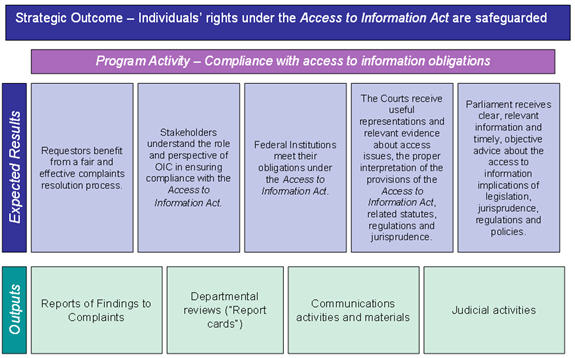Common menu bar links
Breadcrumb Trail
ARCHIVED - Office of the Information Commissioner of Canada
 This page has been archived.
This page has been archived.
Archived Content
Information identified as archived on the Web is for reference, research or recordkeeping purposes. It has not been altered or updated after the date of archiving. Web pages that are archived on the Web are not subject to the Government of Canada Web Standards. As per the Communications Policy of the Government of Canada, you can request alternate formats on the "Contact Us" page.
Section II: Analysis of Program Activities by Strategic Outcome
2.1 Strategic Outcome
The following section describes the Office’s sole program activity and identifies the expected results, performance indicators and targets for each of them. This section also explains how the Office plans on meeting the expected results and presents financial and non-financial resources that will be dedicated to the sole program activity.
2.1.1 Program Activity: Compliance with access to information obligations

| Performance Indicators | Targets |
|---|---|
| Quality and timeliness of the investigation process (including investigation, legal review, approval and report of findings) | 90% of investigations adhere to quality assurance standards at first round of review |
| Reach to, and feedback from, stakeholders (i.e., the public, requesters, ATIP Coordinators community, other) through: public events, speaking engagements, access to proper web-based and other tools and information | Stakeholders reached through having ready access to the Office’s publications, tools and information namely via a Web site that is redesigned to be comprehensive, up-to-date and user-friendly; and stakeholders feedback generally positive |
| Proportion of investigation recommendations that are adopted and proportion of Report Card recommendations that are adopted | 95% of complaints investigation recommendations are adopted and 80% of Report Card recommendations are adopted |
| Proportion of court cases where judgments support OIC representation (either to sustain or clarify interpretation of related statutes) and/or where OIC evidence was considered as part of court deliberations | 90% of court judgments either support OIC representation and/or consider OIC evidence |
| Value of OIC information and advice provided to Parliamentarians and Parliamentary Committees | 80% of information access-relevant Parliamentary Committee reports refer to OIC advice; positive feedback from Parliamentarians, Committee Chairs and members |
| Financial Resources ($ thousands) | Human Resources (FTEs) | |||||
|---|---|---|---|---|---|---|
| 2009-10 | 2010-11 | 2011-12 | 2009-10 | 2010-11 | 2011-12 | |
| 6,230 | 6,230 | 6,230 | 59 | 59 | 59 | |
Program Activity Summary: The Access to Information Act is the legislative authority for the oversight activities of the Information Commissioner of Canada, which are: to investigate complaints from individuals and corporations; to review the performance of federal institutions; to report results of investigations/reviews and recommendations to complainants, federal institutions, and Parliament; to pursue judicial enforcement and to provide advice to Parliament on access to information matters.
Planning Highlights: In order to achieve the expected results, the Office plans to undertake the following activities:
- Fully implementing a new case workload management model. The OIC has devised a backlog strategy to be fully implemented in 2009-10. In 2008-09 a comprehensive review of the complaints handling process will be completed. The Office has already determined that benefits can be attained from a dedicated intake function and an early resolution function. These two new functions are being implemented on a pilot basis in 2008-09.
- The OIC will be adopting a renewed approach to performance reviews of institutions, addressing broad systemic issues and disseminating best practices. The new reports cards will accurately reflect ongoing efforts by institutions to improve compliance and the process will be linked to the fiscal year performance management framework. The OIC will report on federal institutions’ performance and systemic issues in a Special Report to Parliament.
- Fostering good relations with all the players in the access to information system—from requesters, to complainants, to access professionals, to institutions and to Parliament. The OIC will be promoting, through systemic investigations and communication activities, for increased and sustainable government-wide compliance with the ATIA.
- Focus on recruitment, training and retention. The OIC faces significant HR challenges in delivering on its mandate. Attracting, recruiting, training a highly skilled investigator workforce is becoming a priority. The potential shortage of investigators may become a key obstacle to meeting targets over the next several years.
Benefits for Canadians: This program activity which represents the mandate of the Office helps to ensure that federal institutions comply with access to information obligations contained in the Access to Information Act. It encourages federal institutions to make information more easily available to the public and helps to keep the federal government accountable to Canadians. Overall, this program activity contributes to an open, transparent and accountable government.
2.1.2 Program Activity: Internal Services
Internal Services are groups of related activities and resources that are administered to support the needs of programs and other corporate obligations of an organization. These groups are: Management and Oversight Services; Communications Services; Human Resources Management Services; Financial Management Services; Information Management Services; Information Technology Services; Material Services; Acquisition Services; Travel and Other Administrative Services. Internal Services include only those activities and resources that apply across an organization and not those provided specifically to a program.
| Financial Resources ($ thousands) | Human Resources (Full-time Equivalents) | |||||
|---|---|---|---|---|---|---|
| 2009-10 | 2010-11 | 2011-12 | 2009-10 | 2010-11 | 2011-12 | |
| 2,275 | 2,275 | 2,275 | 23 | 23 | 23 | |
